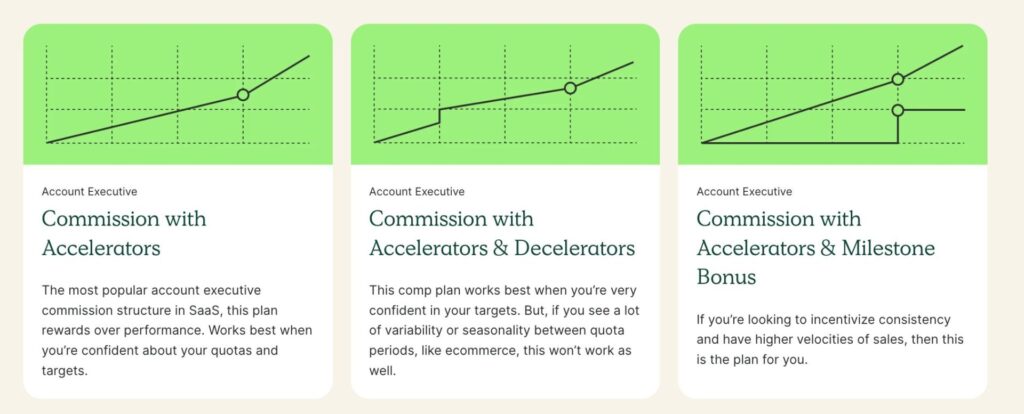A tiered commission structure is a type of commission structure in which the commission rate increases as the sales volume increases. This type of structure is often used to motivate sales reps to achieve higher sales goals and overachieve.
Understanding Tiered Commission Structures
A tiered commission structure typically has two or more tiers, each with its own commission rate. For example, a sales rep might earn a 10% commission on the first $100,000 in sales, a 15% commission on the next $100,000 in sales, and a 20% commission on any sales over $200,000.
Benefits of Implementing a Tiered Commission Structure
Tiered commission structures can be a valuable tool for motivating sales reps and ensuring they are rewarded for their hard work.
Here are five advantages to a tiered commission structure:
| Increased Sales Team Motivation | Tiered structures can motivate salespeople to strive for higher performance. By offering increased rewards for achieving specific targets, you can encourage greater effort and dedication. |
| Improved Performance | The prospect of higher commissions can drive salespeople to exceed expectations and close more deals. This can lead to increased revenue and market share. |
| Better Sales Team Alignment | Tiered structures can align salespeople’s goals with overall company objectives. By setting clear performance benchmarks and rewards, you can ensure that everyone is working towards the same targets. |
| Enhanced Customer Satisfaction | When salespeople are motivated to perform at their best, they are more likely to provide excellent customer service. This can lead to increased customer satisfaction and loyalty. |
| Cost-Effective Compensation | Tiered structures can be a cost-effective way to reward salespeople. You can avoid unnecessary expenses by paying higher commissions only to those who consistently exceed expectations. |
Check out our Compensation Templates for customizable commission plans.
Examples From the Real World
Below are a few examples of tiered structures that can be customized to meet the specific needs of your business. You can also combine or add different tiers to create a more complex structure.
Simple Tiered Structure:
- Tier 1: Up to 50% of quota – 3% commission rate
- Tier 2: 51-100% of quota – 4% commission rate
- Tier 3: Over 100% of quota – 5% commission rate
Volume-Based Tiered Structure:
- Tier 1: 0-10 deals closed – 3% commission rate
- Tier 2: 11-20 deals closed – 4% commission rate
- Tier 3: 21+ deals closed – 5% commission rate
Revenue-Based Tiered Structure:
- Tier 1: 0-$100,000 in sales – 3% commission rate
- Tier 2: $100,001-$200,000 in sales – 4% commission rate
- Tier 3: $200,001+ in sales – 5% commission rate
Challenges to Solve
Here are some additional challenges or considerations to work through before implementing a tiered commission structure:
- The type of sales: Some types of sales are more conducive to tiered commission structures than others. For example, tiered commission structures work well for complex sales that require the cooperation of multiple sales reps.
- The size of your sales team: Tiered commission structures can be difficult to manage if you have a large sales team. If you have a small sales team, a tiered commission structure may be easier to manage.
- Effective rates: Make sure your accelerators (the increased commission rates) maintain an effective rate that rewards the sellers but doesn’t overpay by diluting the profit of the sale.
- Using a sales commission tracking system like QuotaPath will help absolve you of the complexities that come with calculating tiered commission rates.
Comparing Tiered Commission Structure to Other Commission Models
Now, let’s compare plans with sales commission tiers to those without.
Tiered commission structures offer several advantages over other common commission models. Let’s compare it to two popular alternatives:
1. Straight Commission Structure
- Straight Commission: A fixed percentage of each sale is paid to the salesperson.
- Tiered Commission: Offers varying commission rates based on performance.
Advantages of Tiered Commission:
- Increased motivation: Tiered structures are performance incentives that motivate salespeople to exceed expectations.
- Improved performance: The prospect of higher commissions can drive better results.
- Better alignment: Tiered structures can align sales goals with company objectives.
2. Base Salary + Commission Structure
- Base Salary + Commission: A fixed base salary is combined with a commission on sales.
- Tiered Commission: Offers varying commission rates based on performance.
Advantages of Tiered Commission:
- Increased motivation: Similar to straight commission, tiered structures can motivate salespeople.
- Risk mitigation: A base salary provides a safety net, reducing risk for salespeople.
- Improved performance: Tiered structures can still drive higher performance.
Key Differences:
- Flexibility: Tiered commission structures offer more flexibility in rewarding performance.
- Alignment: Tiered structures can be better aligned with specific goals, such as increasing market share or improving customer satisfaction.
- Motivation: The prospect of higher tiers can be a powerful motivator for salespeople.
So, tiered commission structures can be a highly effective way to incentivize salespeople and drive performance. But remember to design your tiered structure carefully to create a compensation plan that aligns with your business goals and motivates your sales team.

